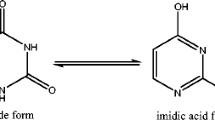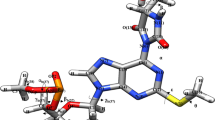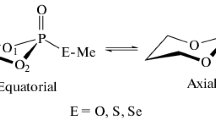Abstract
Conformational preferences of the modified nucleosides N2-methylguanosine (m2G) and N2, N2-dimethylguanosine (m 22 G) have been studied theoretically by using quantum chemical perturbative configuration interaction with localized orbitals (PCILO) method. Automated complete geometry optimization using semiempirical quantum chemical RM1, along with ab initio molecular orbital Hartree–Fock (HF-SCF), and density functional theory (DFT) calculations has also been made to compare the salient features. Single-point energy calculation studies have been made on various models of m2G26:C/A/U44 and m 22 G26:C/A/U44. The glycosyl torsion angle prefers “syn” (χ = 286°) conformation for m2G and m 22 G molecules. These conformations are stabilized by N(3)–HC2′ and N(3)–HC3′ by replacing weak interaction between O5′–HC(8). The N2-methyl substituent of (m2G26) prefers “proximal” or s-trans conformation. It may also prefer “distal” or s-cis conformation that allows base pairing with A/U44 instead of C at the hinge region. Thus, N2-methyl group of m2G may have energetically two stable s-trans m2G:C/A/U or s-cis m2G:A/U rotamers. This could be because of free rotations around C–N bond. Similarly, N2, N2-dimethyl substituent of (m 22 G) prefers “distal” conformation that may allow base pairing with A/U instead of C at 44th position. Such orientations of m2G and m 22 G could play an important role in base-stacking interactions at the hinge region of tRNA during protein biosynthesis process.
















Similar content being viewed by others
References
Dunn, D. B. (1959). Additional components in ribonucleic acid of rat-liver fractions. Biochimica et Biophysica Acta, 34, 286–288.
Smith, J. D., & Dunn, D. B. (1959). The occurrence of methylated guanines in ribonucleic acids from several sources. The Biochemical Journal, 72, 294–301.
Adamiak, R. W., & Gornicki, P. (1985). Hypermodified nucleosides of tRNA: Synthesis, chemistry, and structural features of biological interest. Progress in Nucleic Acid Research and Molecular Biology, 32, 27–74.
Motorin, Y., Bec, G., Tewari, R., & Grosjean, H. (1997). Transfer RNA recognition by the Escherichia coli delta2-isopentenyl-pyrophosphate: tRNA delta2-isopentenyl transferase: Dependence on the anticodon arm structure. RNA, 3, 721–733.
Morin, A., Auxilien, S., Senger, B., Tewari, R., & Grosjean, H. (1998). Structural requirements for enzymatic formation of threonylcarbamoyladenosine (t6A) in tRNA: An in vivo study with Xenopus laevis oocytes. RNA, 4, 24–37.
Limbach, P. A., Crain, P. F., & McClowskey, J. A. (1994). Summary: The modified nucleosides of RNA. Nucleic Acids Research, 22, 2183–2196.
Persson, B. C. (1993). Modification of tRNA as a regulatory device. Molecular Microbiology, 8, 1011–1016.
Agris, P. F. (1996). The importance of being modified: Roles of modified nucleosides and Mg2+ in RNA structure and function. Progress in Nucleic Acid Research and Molecular Biology, 53, 79–129.
Agris, P. F., Vendeix, F. A. P., & Graham, W. D. (2007). tRNA’s wobble decoding of the genome: 40 years of modification. Journal of Molecular Biology, 366, 1–13.
Bjork, G. R., & Hagervall, T. G. (2005). Transfer RNA modification, in Escherichia coli and Salmonella. In R. Curtiss III, A. Bock, J. L. Ingrahan, J. B. Kaper, S. Maloy, & F. C. Neidhardt (Eds.), Cellular and molecular biology. Washington, DC: ASM.
Giege, R. (2006). The early history of tRNA recognition by aminoacyl-tRNA synthetases. Journal of Biosciences, 31, 477–488.
Steinberg, S., & Cedergren, R. (1995). A correlation between N2-dimethylguanosine presence and alternate tRNA conformers. RNA, 1, 886–891.
Noon, K. R., Guymon, R., Crain, P. F., McCloskey, J. A., Thomm, M., Lim, J., et al. (2003). Influence of temperature on tRNA modification in archaea: Methanococcoides burtonii (optimum growth temperature [T opt], 23°C) and Stetteria hydrogenophila (T opt, 95°C). Journal of Bacteriology, 185, 5483–5490.
Grosjean, H., Sprinzl, M., & Steinberg, S. (1995). Posttranscriptionally modified nucleosides in transfer RNA: Their locations and frequencies. Biochimie, 77, 139–141.
Sprinzl, M., & Vassilenko, K. S. (2005). Compilation of tRNA sequences and sequences of tRNA genes. Nucleic Acids Research, 33, 139–140.
Johnson, G. D., Pirtle, I. L., & Pirtle, R. M. (1985). The nucleotide sequence of tyrosine tRNAQ*ΨA from bovine liver. Archives of Biochemistry and Biophysics, 236, 448–453.
Auffinger, P., & Westhof, E. (1998). In H. Grosjean & R. Benne (Eds.), Editing modification of RNA (pp. 569–576). Washington, DC: ASM.
Kowalak, J. A., Dalluge, J. J., McCloskey, J. A., & Stetter, K. O. (1994). The role of posttranscriptional modification in stabilization of transfer RNA from hyperthermophiles. Biochemistry, 33, 7869–7876.
Sprinzl, M., Horn, C., Brown, M., Ioudovitch, A., & Steinberg, S. (1998). Compilation of tRNA sequences and sequences of tRNA genes. Nucleic Acids Research, 26, 148–153.
Maden, B. E. H. (1990). The numerous modified nucleotides in eukaryotic ribosomal RNA. Progress in Nucleic Acid Research and Molecular Biology, 39, 241–303.
Rozenski, J., Crain, P. F., & McCloskey, J. A. (1999). The RNA modification database. Nucleic Acids Research, 27, 196–197.
Davis, D. R. (1998). Biophysical and conformational properties of modified nucleosides in RNA (nuclear magnetic resonance studies). In H. Grosjean & R. Benne (Eds.), Modification and editing of RNA (pp. 85–102). Washington, DC: ASM.
Sussman, J. L., Holbrook, S. R., Warrant, R. W., Church, G. M., & Kim, S. H. (1978). Crystal structure of yeast phenylalanine transfer RNA 1. Crystallographic refinement. Journal of Molecular Biology, 123, 607–630.
Edqvist, J., Straby, K. B., & Grosjean, H. (1995). Enzymatic formation of N2, N2 dimethylguanosine in eukaryotic tRNA: Importance of the tRNA architecture. Biochimie, 77, 54–61.
Edqvist, J., Blomqvist, K., & Straby, K. B. (1994). Structural elements in yeast tRNAs required for homologous modification of guanosine-26 into dimethylguanosine-26 by the yeast Trm1 tRNA-modifying enzyme. Biochemistry, 33, 9546–9551.
Boyle, J., Robillard, G. T., & Kim, S. H. (1980). Sequential folding of transfer RNA: A nuclear magnetic resonance study of successively longer tRNA fragments with a common 5′ end. Journal of Molecular Biology, 139, 601–625.
Ginell, S. L., & Parthasarathy, R. (1978). Conformation of N2-methylguanosine, a modified nucleoside of tRNA. Biochemical and Biophysical Research Communications, 84, 886–894.
Rife, J. P., Cheng, C. S., Moore, P. B., & Strobel, S. A. (1998). N2-methylguanosine is iso-energetic with guanosine in RNA duplexes and GNRA tetraloops. Nucleic Acids Research, 26, 3640–3644.
Kumbhar, N. M., & Sonawane, K. D. (2011). Iso-energetic multiple conformations of hypermodified nucleic acid base Wybutine (yW) which occur at 37th position in anticodon loop of tRNAPhe. Journal of Molecular Graphics and Modelling, 29, 935–946.
Nandel, F. S., & Saini, A. (2011). Peptoids with aliphatic side chains as helical structures without hydrogen bonds and collagen/inverse-collagen type structures. Journal of Biophysical Chemistry, 2, 37–48.
Sonawane, K. D., & Tewari, R. (2008). Conformational preferences of hypermodified nucleoside lysidine (k2C) occurring at “wobble” position in anticodon loop of tRNAIle. Nucleosides, Nucleotides and Nucleic Acids, 27, 1158–1174.
Sonawane, K. D., Sonavane, U. B., & Tewari, R. (2002). Conformational preferences of anticodon 3′-adjacent hypermodified nucleic acid base cis- or trans-zeatin and its 2-methylthio derivative, cis- or trans-ms2zeatin. Journal of Biomolecular Structure and Dynamics, 19, 637–648.
Sonavane, U. B., Sonawane, K. D., & Tewari, R. (2002). Conformational preferences of the base substituent in hypermodified nucleotide queuosine 5′-monophosphate ‘pQ’ and protonated variant ‘pQH+’. Journal of Biomolecular Structure and Dynamics, 20, 473–485.
Tewari, R. (1987). Theoretical studies on conformational preference of modified nucleic acid base N6-(N-threonylcarbonyl) adenine. Indian Journal of Biochemistry and Biophysics, 24, 170–176.
Tewari, R. (1990). Conformational preferences of modified nucleic acid bases N6-methyl-N6-(N-threonylcarbonyl) adenine and 2-methylthion-N6-(N-threonylcarbonyl) adenine by quantum chemical PCILO calculations. Journal of Biomolecular Structure and Dynamics, 8, 675–686.
Sonavane, U. B., Sonawane, K. D., Morin, A., Grosjean, H., & Tewari, R. (1999). N (7) protonation induced conformational flipping in hypermodified nucleic acid bases N6 (N-threonylcarbonyl) adenine and its 2-methylthio- or N(6)-methyl-derivatives. International Journal of Quantum Chemistry, 75, 223–229.
Tewari, R. (1995). N(7)-protonation-induced conformational flipping in hypermodified nucleic acid base N6-(N-glycylcarbonyl) adenine. Chemical Physics Letters, 238, 365–370.
Tewari, R. (1988). Conformational preferences of modified nucleic acid bases N 6-(Δ2-isopentenyl) adenine and 2-methylthio-N 6-(Δ2-isopentenyl) adenine by the quantum chemical PCILO calculations. International Journal of Quantum Chemistry, 34, 133–142.
Tewari, R. (1992). Conformational preferences of 6-furfuryl amino purine and 6-benzyl amino purine. International Journal of Quantum Chemistry, 41, 709–718.
Sonawane, K. D., Sonavane, U. B., & Tewari, R. (2000). Conformational flipping of the N(6) substituent in diprotonated N6-(N-glycylcarbonyl)adenines: The role of N(6)H in purine-ring-protonated ureido adenines. International Journal of Quantum Chemistry, 78, 398–405.
Tewari, R. (1997). Influence of N(1) protonation on the orientation of the N(6) substituent in hypermodified nucleic acid base N6-(N-glycylcarbonyl) adenine. International Journal of Quantum Chemistry, 62, 551–556.
Tewari, R. (1994). Protonation-induced conformational flipping in hypermodified nucleic acid base N6-(N-glycylcarbonyl) adenine. International Journal of Quantum Chemistry, 51, 105–112.
Holbrook, S. R., Sussman, J. L., Warrant, R. W., & Kim, S. H. (1978). Crystal structure of yeast phenylalanine transfer RNA: II. Structural features and functional implications. Journal of Molecular Biology, 123, 631–660.
Diner, S., Malrieu, J. P., & Claverie, P. (1969). Localized bond orbitals and the correlation problem. Theoretical Chemistry Accounts, 13, 1–17.
Diner, S., Malrieu, J. P., Jordan, F., & Gilbert, M. (1969). Localized bond orbitals and the correlation problem III. Energy up to third order in the zero differential overlap approximation. Application to σ electron systems. Theoretical Chemistry Accounts, 15, 100–110.
Masson, A., Levy, B., & Malrieu, J. P. (1970). Formaldehyde calculation of energy in the ground state by a perturbation method. Theoretical Chemistry Accounts, 18, 193–207.
Pullman, B., & Pullman, A. (1974). Molecular orbital calculations on the conformation of amino acid residues of proteins. Advances in Protein Chemistry, 16, 347–526.
Pullman, B., & Saran, A. (1976). Quantum-mechanical studies on the conformation of nucleic acids and their constituents. Progress in Nucleic Acid Research and Molecular Biology, 18, 215–326.
Tewari, R. (1987). Theoretical studies on conformational preferences of modified nucleic acid base N6-(N-glycylcarbonyl) adenine. International Journal of Quantum Chemistry, 31, 611–624.
Stewart, J. J. P. (1991). Optimization of parameters for semiempirical methods. III Extension of PM3 to Be, Mg, Zn, Ga, Ge, As, Se, Cd, In, Sn, Sb, Te, Hg, Tl, Pb, and Bi. Journal of Computational Chemistry, 12, 320–341.
Rocha, G. B., Freire, R. O., Simas, A. M., & Stewart, J. P. (2006). RM1: A reparameterization of AM1 for H, C, N, O, P, S, F, Cl, Br, and I. Journal of Computational Chemistry, 27, 1101–1111.
Becke, A. D. (1992). Density-functional thermochemistry. III. The role of exact exchange. The Journal of Chemical Physics, 98, 5648–5652.
Francl, M. M., Pietro, W. J., & Hehre, W. J. (1982). Self-consistent molecular orbital methods. XXIII. A polarization-type basis set for second-row elements. The Journal of Chemical Physics, 77, 3654–3665.
Hehre, W. J., Radom, L., Schleyer, P. V. R., & Pople, J. A. (1986). In ab initio molecular orbital theory. New York: Wiley.
Shi, H., & Moore, P. B. (2000). The crystal structure of yeast phenylalanine tRNA at 1.93 A resolution: A classic structure revisited. RNA, 6, 1091–1105.
Pallan, P. S., Kreutz, C., & Bosio, S. (2008). Effects of N2, N2-dimethylguanosine on RNA structure and stability: Crystal structure of an RNA duplex with tandem m 22 G: A pairs. RNA, 14, 2125–2135.
Parmeggiani, A., Krab, I. M., Watanabe, T., Nielsen, R. C., Dahlberg, C., Nyborg, J., et al. (2006). Enacyloxin IIa pinpoints a binding pocket of elongation factor Tu for development of novel antibiotics. Journal of Biological Chemistry, 281, 2893–2900.
Author information
Authors and Affiliations
Corresponding author
Electronic supplementary material
Below is the link to the electronic supplementary material.
Rights and permissions
About this article
Cite this article
Bavi, R.S., Kamble, A.D., Kumbhar, N.M. et al. Conformational Preferences of Modified Nucleoside N2-methylguanosine (m2G) and Its Derivative N2, N2-dimethylguanosine (m 22 G) Occur at 26th Position (Hinge Region) in tRNA. Cell Biochem Biophys 61, 507–521 (2011). https://doi.org/10.1007/s12013-011-9233-1
Published:
Issue Date:
DOI: https://doi.org/10.1007/s12013-011-9233-1




